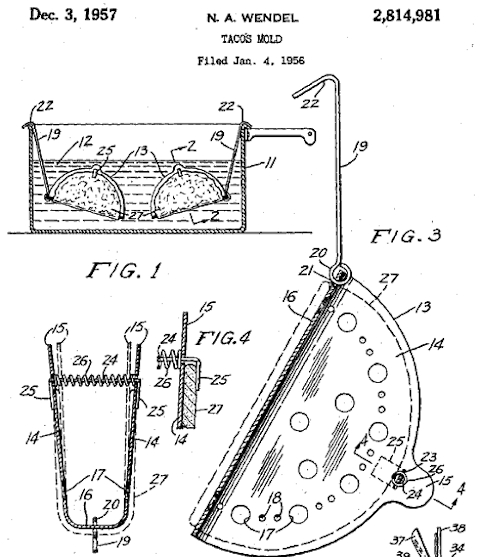Out in the outer boroughs today, trying to hook up a geographical shift for Microkhan world headquarters. As much as I’ve loved living in Atlah, this shoebox-sized abode has become intolerable; I blame all lousy writing on the fact that I’ve been reduced to working on the floor of Microkhan Jr.’s room during school hours. As I sniff around for brand new digs, enjoy the footage of history’s greatest hammer throwers; note how the wind-and-spin technique has become much more refined over the decades.
Picking Up the Yurts
May 10th, 2011
Comments Off on Picking Up the YurtsTags:hammer throw·sports
Soft Time in Finland
May 9th, 2011
Buried in this account of a Rwandan-born, Kansas-based octogenarian who may be a genocidaire is an interesting tidbit regarding Finnish jurisprudence:
Mr. Kobagaya did not come to the United States government’s attention until December 2007, when he agreed to testify as a defense witness on behalf of a former neighbor, Francois Bazaramba, in a trial in Finland. Mr. Bazaramba was facing charges that he had organized the genocide in Birambo. Finnish prosecutors tipped off American officials about Mr. Kobagaya’s testimony, which showed he was in Rwanda during the genocide, not Burundi. (Last summer, Mr. Bazaramba was convicted on genocide charges and sentenced to life in a Finnish prison.)
There is something slightly dissonant about the phrase “Finnish prison,” perhaps because Finland’s penal system is so famously easygoing. This 2003 piece makes the case that life in a Finnish correctional facility ain’t half bad:
Walls and fences have been removed in favor of unobtrusive camera surveillance and electronic alert networks. Instead of clanging iron gates, metal passageways and grim cells, there are linoleum-floored hallways lined with living spaces for inmates that resemble dormitory rooms more than lockups in a slammer.
Guards are unarmed and wear either civilian clothes or uniforms free of emblems like chevrons and epaulettes. ”There are 10 guns in this prison, and they are all in my safe,” Mr. Aaltonen said.
”The only time I take them out is for transfer of prisoners.”
At the ”open” prisons, inmates and guards address each other by first name. Prison superintendents go by nonmilitary titles like manager or governor, and prisoners are sometimes referred to as ”clients” or, if they are youths, ”pupils.”
”We are parents, that’s what we are,” said Kirsti Njeminen, governor of the Kerava prison that specializes in rehabilitating young offenders like Mr. Syvajarvi.
Generous home leaves are available, particularly as the end of a sentence nears, and for midterm inmates, there are houses on the grounds, with privacy assured, where they can spend up to four days at a time with visiting spouses and children.
”We believe that the loss of freedom is the major punishment, so we try to make it as nice inside as possible,” said Merja Toivonen, a supervisor at Hameenlinna.
I by no means think that America’s penal system should be similarly cozy. But I am curious to know more about how Finland’s style of incarceration, which began in the early-to-mid-1990s, has affected the nation’s crime rate. One thing I do know right off the bat, and which may raise some issues: Finland has an unusually high homicide rate, especially in its northern provinces.
→ 1 CommentTags:crime·Finland·genocide·murder·prisons·Rwanda
“He Stayed to Write a Grander Legend”
May 6th, 2011
Since I can scarcely imagine life without the biological rocket fuel known as caffeine, I’m counting my lucky stars this morning that I’m not a Cuban. That’s because sky-high coffee prices have forced the government to cut rations, meaning that Cuba’s java addicts must now satisfy their urges with a beverage partly concocted from roasted peas. One can only hope that easy access to sugar cane will be the poor coffee drinkers’ saving grace.
Yet these deprivations have rarely fazed the Cubans; in fact, the Castro regime has survived for so long because of its ability to convince the populace that triumph over such hardships represents triumph over those who wish the nation ill. And the government is aided in this communications endeavor by those increasingly rare souls who made even greater sacrifices for the revolutionary cause—chief among them Teofilo Stevenson, the greatest heavyweight boxer who never quite was, at least in the professional sense.
Pugilistic enthusiasts never tire of speculating on whether Stevenson, a great Olympic champion, could have taken the heavyweight crown from Muhammad Ali in the 1970s. We never got a satisfactory answer to that question because Stevenson refused to defect, despite being presented with many an enticing opportunity. His reward for that willpower has been adulation in Cuba, rather than anything material comfort. As this great 2002 profile reveals, Stevenson’s privileges are scant compared to what he would have received in any other country:
The man who could have fought Muhammad Ali – no, more than that: who could have been Muhammad Ali, famous throughout the world and rich beyond imagining – was fully awake after a drowsy morning. He said he’d be ready to go to lunch as soon as he washed up and changed his clothes. Here’s what Teofilo Stevenson did next: He took a big galvanised bucket out to the front yard, filled it with water from the garden tap, lugged the bucket inside, hoisted it on top of the kitchen range and turned on the flame…
Stevenson went inside twice to check the water on the stove. When it was hot, he carried it to the bathroom and poured it into the tub. Now he could take a bath. There’s no hot water from the tap at the house of the man who could have been Muhammad Ali, just cold…
The house is far from sumptuous, but comfortable – spotless linoleum floors, casement windows framed by floral curtains, utilitarian furniture. There is even a small swimming pool filling the little back yard, though it contains just a couple of feet of black, brackish water. Stevenson explained that it was far too expensive to fill and maintain the thing.
I wonder how many of Stevenson’s houses could fit inside Mike Tyson’s abandoned Ohio manion.
→ 3 CommentsTags:boxing·Communism·Cuba·Mike Tyson·sports·Teofilo Stevenson
Nonlinear Athletic Niches
May 5th, 2011
 I’m heading upstate today to attend a workout with a world-class track-and-field athlete, as part of my reporting for a story about the limits (or lack thereof) of human performance. In the course of my research, I’ve had occasion to give a lot of thought to nonlinear athletic niches, a spin on the economic phenomenon previously discussed on Microkhan. Why do some nations tend to dominate certain off-the-beaten-path sports? There are clues to be found in this examination of Finnish javelin throwers, who have long ranked at the top of that sport’s tables. One of the more convincing pieces of theorizing:
I’m heading upstate today to attend a workout with a world-class track-and-field athlete, as part of my reporting for a story about the limits (or lack thereof) of human performance. In the course of my research, I’ve had occasion to give a lot of thought to nonlinear athletic niches, a spin on the economic phenomenon previously discussed on Microkhan. Why do some nations tend to dominate certain off-the-beaten-path sports? There are clues to be found in this examination of Finnish javelin throwers, who have long ranked at the top of that sport’s tables. One of the more convincing pieces of theorizing:
It is by no means a secret that there was money around in Finnish sports as early as the 1920s. Paavo Nurmi‘s hectic racing schedule on his home tracks as well as in Europe and the United States was the firm background for his later success as a business man and building contractor.
As for the javelin throw, sportswriter Urho Salo tells an interesting story. The late Yrjo Nikkanen – a magnificent natural talent, whose world record of 78.70m from 1938 stood for 15 years – told him he sometimes earned ‘an equivalent of an army officer’s monthly wages in one meet as an under-the-table payment – and there were many meets like that during the summer’.
According to sports historian Anttoi O. Arponen, ‘thanks to his javelin capacity, a poor country boy could become a member of a leading club, at the same time getting better-paid work and climbing higher on the social ladder’.
And a hypothesis that I don’t quite buy, though I certainly appreciate its poetry:
‘The Finns have been moulded psychologically by the extremes of their climate,’ says Turner. ‘Long dark winters and short glorious summers have produced the archetypal strong but silent national character. The javelin suits the Finns, providing an emotional release for all their pent-up feelings. It’s the dual release of spear and emotion which the Finns so much enjoy.’
Current world rankings for men’s javelin here. The top American is a good 10 meters off the pace.
The Hazards of Herding Blitzen
May 4th, 2011

In case you don’t keep regular tabs on Scandinavian jurisprudence, I’d like to draw your attention to a recent legal triumph by a group of Sami reindeer herders who operate in Sweden’s forbidding north. After 14 years of litigation, the herders have finally won the right to let their animals graze in the forests around Nordmaling, which are privately owned. Sami activists claim that the victory ensures the survival of their traditional profession, and thus continued sustenance for those who enjoy a nice slice of reindeer every now and then.
But while future generations of Sami herders might now be guaranteed grazing rights, their profession will continue to be far from stable. That is because tending to reindeer remains a fantastically perilous way to make one’s living—so much so that it has attracted plenty of attention from occupational safety researchers, who are keen to reduce the endeavor’s sky-high fatality rate. This 2004 study details the perils:
Reindeer herding implies many hazardous situations, especially during the gathering of the reindeer for migration or slaughter. During these periods the herders use vehicles to gather the reindeer (i.e. motorcycles, snowmobiles, helicopters, airplanes and boats), and the work is often executed during long working hours in harsh climate. For instance, it has been shown that most reindeer-herding men spend approximately 800 hours per winter on snowmobile. The increasing number of work-related fatal accidents among the reindeer herders is probably related to an increasing pressure from the Swedish society to develop profitable reindeer herding companies with less dependence on governmental support. This has resulted in external socio-economic pressure and competition between the family companies within the Sami communities, which in turn has forced the enterprises to make costly investments in vehicles to save time and personnel expenses…
The high number of work-related accidents among reindeer herders puts reindeer herding at the top among the most hazardous occupations in Sweden. A comparison of the present results and official statistics on work-related accidents in different occupations shows that work-related fatal accidents are more than twice as common among reindeer herders than within the agricultural and the building- construction sectors.
Still, it does seem a fair bit safer than elephant training.
→ 1 CommentTags:agriculture·elephants·public health·reindeer·Sami·Sweden
Hiding in Plain Sight
May 3rd, 2011

I somehow doubt we’ll ever hear the full story regarding what Pakistan’s intelligence apparatus knew about Osama bin Laden’s whereabouts these past five years. It is totally naïve to think they knew naught, of course; the big question is who in the spook food chain was in on the conspiracy, and (perhaps most important) what they stood to gain from keeping the matter under wraps.
My pessimism about the eventual resolution of these mysteries stems from past experience. Time and again, big-name fugitives have been found hiding in plain sight, obviously having enjoyed the protection of powerful figures. Yet no one ever seems to suffer any consequences for this sort of aiding and abetting—to mod an infamous Leona Helmsley quote, only the little people get pinched for helping evildoers. My favorite example of this truism pertains to the case of Salvatore Riina, the onetime boss of the Sicilian Mafia, who made bin Laden’s time on the lam seem like child’s play. Bin Laden, at least, reportedly kept to himself indoors; when he wasn’t luxuriating in his massive hilltop villa, Riina milled about downtown Palermo at will:
During the 23 years that Salvatore Riina lived as a fugitive, he married in the church, fathered four children born in the same clinic, circulated freely in Palermo and ruled as dictator over the Mafia.
That freedom ended with his arrest in the Sicilian capital Friday. Amid the banner headlines and expressions of joy, many Italians asked how the country’s most wanted man could have avoided capture so long…
Asked why it took so long to capture Riina, Carabinieri commander Antonio Viesti said he was protected by a “network of cover.”
It’s easy to see why the members of that network were never brought to account: They likely controlled the very apparatus charged with investigating the affair. I have no doubt that the people complicit in protecting bin Laden wield similar authority in Pakistan. In fact, those who provided cover for bin Laden will likely be the same officials who now crow the most loudly about the benefits of his demise. In corrupt systems such as early 1990s Sicily or modern-day Pakistan, the elites who last are those most adepts at playing both sides of the coin.
→ 4 CommentsTags:corruption·crime·organized crime·Osama bin Laden·politics·Salvatore Riina·Sicily·terrorism
Let it All Come Down
May 2nd, 2011

If you desire a brief respite from today’s deluge of bin Laden-related news and punditry, take a sec to check out the work of Bern Will Brown. He’s sort of the Paul Gaugin of the frozen north, having settled into the tiny Arctic hamlet of Colville Lake many decades ago. Though he originally journeyed up to Canada’s northern climes as a Catholic missionary, he’s now best known for his depictions of daily life in the Northwest Territories’ remotest corners; along with his paintings, his 16mm film of Beluga whale hunting comes highly recommended.
Comments Off on Let it All Come DownTags:Arctic·art·Bern Will Brown·Canada·Colville Lake·film·Native Americans·painting
Over the Bridge
April 29th, 2011
Have a date with the American bureaucracy this morning, so zipping out with a lil’ vintage Turkish funk. First got turned on to the tune above by a sample from Action Bronson’s decidedly NSFW “The Madness”, which I initially mistook for a new Ghostface cut. Not sure I’m tempted to sift through Ferdi Özbğen‘s entire back catalog, since it seems like a lot of it tends toward a Turkish Tom Jones vibe. But great to see producers following Madlib’s lead and digging through ever more far-flung crates. I’m all for ditching those overused Isley Brothers’ samples in favor of more Ivo’s Group.
Comments Off on Over the BridgeTags:Ferdi Özbğen·hip-hop·Madlib·music·Turkey
Requiem for the Slug Kings
April 28th, 2011

A surprising number of tears were shed when the world’s last manual-typewriter factory announced its shuttering a few days back. Once again, generations of technological know-how are set to evaporate as a once state-of-the-art invention tumbles into museum mode.
The manual typewriter industry’s long-anticipated demise got me thinking about engineering wizards whose skills have been outmoded by the relentless march of technology. As a New Yorker, the first folks who popped to mind were Kim Gibbs and Alan Campbell, the so-called Slug Kings, who made minor fortunes in the ’80s and early ’90s by manufacturing counterfeit subway tokens. Operating behind a Midtown front business called KG Delivery Service, Gibbs and Campbell churned out untold thousands, if not millions, of brass discs that would permit their bearers to enter the city’s subway system for a relative song. In 1991, Campbell described the technology and expertise invovled:
Around 1970 – the year the fare increased from 20 to 30 cents, triggering a mad run on all available slug supplies – Campbell was introduced, by chance, to the wonders of the reciprocating press, an industrial-strength hole puncher. He bought his own.
“The metal is slipped into long coils – really big ones are 300 pounds – and fed through the press,” he recalled. “I believe it was Russians who figured out that a submachine gun could be made from a reciprocating press. Making a slug is the easiest and simplest use of the reciprocating press. You could make up to a million if you kept the machine going.”
How many was he selling? “As far as the total, I didn’t want documents like that in my possession,” he said. “Sometimes I used newspaper articles to track it.” In those early years, one could read that 2,000, 8,000, 10,000, slugs a day were being collected from turnstiles. On his prices, he is vague – “variable rates; at one point I raised it to 15 cents” – and while he has a diary somewhere, he believes any figures would sound deceptively large.
Much more here. I like how Gibbs and Campbell had a nickname for their counterfeiting ring: “The Ministry.” Makes me think they spent way too much time studying the villains from Justice League.
→ 1 CommentTags:crime·economics·New York City·subways·technology·transportation·typewriters
Mushrooms for Strength
April 27th, 2011
 I’m currently up to my eyeballs in research on a piece about Soviet athletic excellence, which was a more enigmatic phenomenon than most folks realize. There really isn’t one definitive explanation for the nation’s sporting success throughout its last three decades of existence, though there are certainly plenty of theories. As I’ve become immersed in the topic, I’ve started to believe that the primary reason for the Soviets’ athletic achievement was total dedication, made possible by a system that offered unusually special privileges to those who gave up their entire lives in pursuit of world records—many of which are still held by Soviets who competed in the 1980s. For a small glimpse of the devotion required to be an elite Soviet athlete during this time period, I encourage you to check out this interview with hockey star Anatoly Firsov, who discusses (in poorly translated English) the constant effort demanded by his coach, the legendary Anatoli Tarasov:
I’m currently up to my eyeballs in research on a piece about Soviet athletic excellence, which was a more enigmatic phenomenon than most folks realize. There really isn’t one definitive explanation for the nation’s sporting success throughout its last three decades of existence, though there are certainly plenty of theories. As I’ve become immersed in the topic, I’ve started to believe that the primary reason for the Soviets’ athletic achievement was total dedication, made possible by a system that offered unusually special privileges to those who gave up their entire lives in pursuit of world records—many of which are still held by Soviets who competed in the 1980s. For a small glimpse of the devotion required to be an elite Soviet athlete during this time period, I encourage you to check out this interview with hockey star Anatoly Firsov, who discusses (in poorly translated English) the constant effort demanded by his coach, the legendary Anatoli Tarasov:
Lucky were those who were close to [Coach Tarasov]. All out free time with him we were going out. He especially liked to go for mushrooms. He had a place slightly farther than I now have my dacha. We arrived in the evening, went into forest while it is slightly going darker. He gave us some 15-20 minutes, and then we returned after a whistle. And then the most sweet began — preparation of mushrooms, in oil, in sour cream, in own juice. Then we laid down to rest. Early in the morning we wake up, he about 3:00 a.m., we a little bit later. And here I realized for the first time what it costs to me. When he saw, how I pick up mushrooms, — when you calmly came by, bend, cut, put it in, get a joy — he shouted for a half of the forest, “First, what are you doing! You must pick up mushroom! To sit down on one leg, on another leg, land on one buttock, and then tear off the mushroom, not only with one hand, but with another as well, and keep an eye to make sure, that nobody else could pick the mushroom up!” So he in every moment looked for an opportunity to train.
Once, when we after Olympic games, went by train was it to Sverdlovsk or where? Olympic champions, we went in a common 3rd-class carriage, together with everybody else, no special compartment, nothing. On one station, in Kazan, it seems, he suddenly says, “Well, boys, everybody quickly out and begin training. We have 10-minutes stop, and we must train very well.” We had been going already about two days, and for him it was very fearsome that we are without training. So he forced us to jump on steps of a carriage, run, tumble, we were looked at like strange people. “Olympic champions, what they are doing?” But for us it was important to hold a training in any conditions, and when we were tumbling on a platform, people could not understand what are they doing, is it an Olympic team or they are being transported to a crazy house? How it is possible to jump, leap and tumble on a snow, on an asphalt? But for Tarasov there was nothing more important than training with a use.
These anecdotes, of course, remind me of how this East/West paradigm was flipped on his head by the training montage from Rocky IV, in which Ivan Drago uses the latest technology to prepare for the climactic bout, while Sylvester Stallone saws wood in foot-deep snow.
(Image via English Russia)
→ 7 CommentsTags:Anatoli Tarasov·hockey·Rocky IV·Soviet Union·sports
What’s in Wyoming?
April 26th, 2011
Limited time to work today as Microkhan Jr. still has one day left of spring break, which he has apparently decided to spend attempting to coax me into serial games of hide-and-seek. Trying to grab a few hours here and there to focus on what pays the bills ’round this humble yurt, and that means half-assing it on the blog this morning. In lieu of the standard fare, then, enjoy the 39-year-old news clip above, about the bizarre Brooklyn bank heist that inspired Sidney Lumet’s Dog Day Afternoon. Check out the lead robber’s mannerisms in particular, as he gestures to the assembled crowd—Al Pacino just nailed the nuances of those arm waves in the movie.
Comments Off on What’s in Wyoming?Tags:crime·Dog Day Afternoon·movies·New York City
The Folly of Youth
April 25th, 2011
I’m just now getting cranking on a sports-related project—my first crack at writing about the athletic games that adults play since I covered the Nagano Olympics as a mere cub. To get into the right mindset for the challenge, I’ve been looking up the old Sports Illustrated stories that influenced me so deeply as young’un. Though I typically credit my college-age encounters with longform journalism for steering me down my current path, my love of in-depth storytelling actually dates back to my weekly consumption of SI in grade school and junior high. Looking back at some of those great SI pieces now, I’m struck by their artistry and detail; the best of the lot were darn near perfect, little jewels of the craft that deserve to be dissected and analyzed the same as any contemporary David Grann masterpiece.
One of the standouts is a story that I was able to found solely because a couple of lives have never left me. I couldn’t remember anything about this piece save for the fact that it was about prison sports, and that it contained the tragic tale excerpted below—a tale in which the simple observation in bold managed to echo in my noggin’ for the next 23 years:
During his first stint in prison, at the Georgia Training and Development Center in Buford, Leroy Fowler got a chance to go to an Atlanta Braves game as a trustee with Billy Shaw, a guard who also coached the prison baseball team. When they returned to Buford, Fowler told Shaw that he had a better fastball than anybody he had seen that night, and Shaw couldn’t disagree. Fowler had a slider and an overhand curve in addition to what’s reputed to have been a 95-mph heater.
“Fast? Oh, yes sir!” says Shaw, who is now deputy warden, when he’s asked about Fowler’s arm. “Our team barnstormed all over the state back in 1966 and ’67, playing Georgia Southern and a lot of semipro teams. We never lost but a couple of games, and Leroy pitched them all.”
The Cardinals and the Dodgers expressed interest in Fowler and told him to call when he was released. Then, just four days before he was to be paroled, Fowler, who was 20 at the time, escaped with one of his buddies. Why? “I was young and stupid,” says Fowler, realizing even as he speaks that what he did extends beyond stupidity to self-destruction.
Fowler and his pal stole a prison officer’s car and drove to Atlanta, where they watched a Braves game. Six months later Fowler was recaptured, but he escaped again in 1971. This time he went to a Cincinnati Reds try-out in Marietta, Ga., where he used a false name and took his turn with the other pitching hopefuls. Fowler says now of the scouts, “I think they were interested in me. I got to bringin’ it pretty hard. I pitched three innings, and they asked me to come back the next day.” Unfortunately, somebody in the stands who had seen him pitch on the prison team, recognized him, and Fowler ducked out, left town and didn’t return.
A year later, he was recaptured after taking a blast from a policeman’s shotgun in the right arm. He was in the prison hospital for six days before undergoing surgery, and, as he lay there, Fowler asked himself if he was a failure because of fate or bad luck or ignorance or maybe because his arm was an arbitrary gift that made him hope for more than he deserved.
The injury cost him the use of his little finger and caused nerve damage in the ring finger. He rehabilitated the arm as well as he could, but he was through as a prospect. A prospect needs it all. Fowler is now a star on the inmate Softball team, a power hitter with a really good arm and one of those sad stories nobody wants to hear.
I’m not sure why Fowler’s unvarnished admission of idiocy made such an impression on my young brain. It’s partly because even at that young age, I was astounded by the sheer stupidity of his decision to escape. But the line might’ve washed right over me if the writer, Rick Telander, hadn’t somehow managed to make me care about a felon—and in such a modicum of space, to boot. And that is the great trick of nonfiction: To make the reader understand that every character, no matter how high or low, must cope with basic human needs and emotions.
Moving on now to another SI classic from my youth: Gary McLain’s personal account of his cocaine abuse at Villanova. Yes, I have a thing for stories about wasted talent.
→ 5 CommentsTags:Leroy Fowler·prisons·sports·Sports Illustrated·writing
The Scope of the Slithery Problem
April 22nd, 2011

One of the great riddles of epidemiology is the toll of snakebites on India. Various studies over the years have estimated the annual death toll anywhere from 1,300 to 50,000. Until recently, the most convincing analysis out there, based on data from local hospitals, put the number of fatalities at roughly 11,000 per year. But a new study, employing data culled from so-called verbal autopsies, concludes that the problem is much worse than feared:
Snakebite remains an important cause of accidental death in modern India, and its public health importance has been systematically underestimated. The estimated total of 45,900 (95% CI 40,900–50,900) national snakebite deaths in 2005 constitutes about 5% of all injury deaths and nearly 0.5% of all deaths in India. It is more than 30-fold higher than the number declared from official hospital returns. The underreporting of snake bite deaths has a number of possible causes. Most importantly, it is well known that many patients are treated and die outside health facilities – especially in rural areas. Thus rural diseases, be they acute fever deaths from malaria and other infections or bites from snakes or mammals (rabies), are underestimated by routine hospital data. Moreover, even hospital deaths may be missed or not reported as official government returns vary in their reliability, as shown from a study of snakebites in Sri Lanka. The true burden of mortality from snakebite revealed by our study is similar in magnitude to that of some higher profile infectious diseases; for example, there is one snakebite death for every two AIDS deaths in India.
Virtually every death by snakebite is preventable, of course, as long as the victim receives the appropriate anti-venom drug in time. It would seem that it would be relatively cheap to disseminate the most popular remedies to far-flung villages, so that victims who are located a great distance from hospitals can be treated as quickly as possible. But as previously discussed on Microkhan, antivenins are absurdly expensive, since so few drug companies produce them in any quantity. Until now, governments and NGOs haven’t seen fit to apply pressure on such companies to ramp up production. Now that they have good evidence that a vast market awaits in India, perhaps it’s time to state the case for antivenin manufacturing more forcefully. There is money to be made here if a program is created on the national level—and, more important, tens of thousands of lives to be saved.
The Giggle Box Comes Back
April 21st, 2011
I recently watched Client 9: The Rise and Fall of Eliot Spitzer, which I can best describe as surprisingly awesome. As a resident of the Empire State, I thought I had a pretty good handle on our former governor’s self-destruction, but the flick gave me a whole new perspective on the affair. It’s shamelessly pro-Spitzer, and thus glosses over some of his more notable political failings, but it does make a convincing case that he probably deserved a break. His big mistake wasn’t cheating on his wife with call girls, the movie argues; it was being so aggressive on Wall Street and in Albany that the knives were out for him as soon as he slipped up.
What really makes the movie work is the assortment of characters that director Alex Gibney convinced to get in front of his camera. My favorite might be Cecil Suwal, the madam of the escort service that provided Spitzer with his temporary paramours. The New York Times‘ David Carr aptly describes her as “a giggle box of truth”—there’s a great scene (and possible Poncho nominee) in which she bursts out laughing while describing how she calculated the overnight rates for her escorts by simply adding a zero to their hourly rates. It takes you a moment to realize that she’s talking about a sophisticated, multinational call girl ring, rather than the time she and her sorority sisters got drunk and did karaoke in Atlantic City.
Curious khan that I am, I naturally had to know what Suwal was up to these days. She’s out of prison, as is her husband and business partner, Mark Brener (who also happens to be about four decades her senior). The couple is no longer peddling flesh, but rather “success.” Their dodgy-sounding product is called “The Achievers’ System for Finding Joy, Fulfillment and Meaning in Success,” and it’s all described here:
This program contains the key to Creative Genius and the wealth it brings. It is the most Advanced, Complete System for Achievement, Success, Peace of Mind and Happiness. While course registration is yours at $25,000 USD our income is derived primarily from the success you gain after having taken this course.
This 15-week seminar course will change your life. It will enable you to rise to even higher levels of success than ever before. Gain access to the Supreme Powers inside you to structure and create your life according to your most important ideals…
This the first course to make public (largely buried) ancient knowledge and its direct relationship to leading Frontier Science. In the long chain of human evolution, access to such relevant information has never been so timely. Strictly for those accustomed to excellence, this course is that which the best of the best have long needed to reach their newly undiscovered heights…
During the period spent in the “desert” we were able to experience previously unknown facets of life, do personal research and learn from both contemporary and ancient teachers such as M. M. Schneerson, Eckhart Tolle, David Hawkins, Jesus Christ, Eric Kandel, Steven (sic) Hawking and many other beautiful people who in their own, unique ways pierced a few “layers” of, what Kabbalah and other writings call, universal wisdom.
If you read the fine print, you’ll note that the $25,000 course fee is only the beginning of an attendee’s financial commitment to Suwal and Brener. They will also owe the couple 10 percent of the gross profits on every $1 million they earn henceforth.
Personally, I’m skeptical that anyone who gets a “Property of Mark Brener” tattoo by their privates has a firm understanding of the mysteries of human existence. But if any Microkhan readers do take the plunge, please report back.
→ 3 CommentsTags:Cecil Suwal·Client 9·crime·Mark Brener·movies·prostitution
Prick Up Your Ears
April 20th, 2011
It’s been a long time since overtly political music was considered dangerous in this country—as much as I like Dead Prez, for example, I sort of doubt that the FBI is bothering to give the group the John Lennon treatment. But the situation is very different in the anarchic amalgam commonly known as Somalia, a place where the most celebrated musicians have long had the power to stir the pot in a meaningful way. And no one has a better track record of riling up the powers-that-be than Saado Cali Warsame, the fractured country’s most revered female singer.
Warsame’s latest song is “Ha dhigan Dhiigshiil” (above), which roughly translates as “Don’t send your money through Dahabshiil,” the name of a money transfer company popular among Somali expatriates the world over. Warsame accuses Dahabshii of funding Al-Shabaab, the Islamic fundamentalist insurgency that is fighting to control Somalia. According to this clunkily translated account, the beef between Warsame and Dahabshii is personal:
The company recently lost a court case against a well-known investigative journalist Dahir Abdulle Alasow in Breda Netherlands, after the company accused the reporter of humiliating figures in the company, goodwill defamation and accusation related to Dahabshiil’s attempt to assassinate singer Sado Warsame.
The song relates Dahabshiil to Alshabab, a militant group allied to Alqaeda which rules much of Southern Somalia with brutal laws, and a slow genocide going on in the Sool, Sanag and Ceyn (SSC) regions in Somalia by Somaliland forces, which Warsame is originally from.
Dahabshiil rejected the accusation and sued the investigative reporter whose website waagacusub.com published the articles relating Dahabshiil attempt to assassinate the artist Warsame and the linkage to the terror group and the slow genocide in SSC regions. But the judge in Breda district court ruled out Dahabshiil’s argument and ordered the reporter to keep doing his job freely, and states the accusation as baseless.
Dahabshii has much to fear from Warsame’s music because she has proven once before that she has the power to influence the Somali masses. Her late 1980s song “Land Cruiser” is credited with helping to bring down the regime of Mohamed Siad Barre, the target of Warsame’s lyrics. Barre was not amused:
The Somalis’ intolerance for Siad Barre became open and truly populist. Fearing the “three o’clock knock” that presaged executions, poets and singers led dissent. Siad muzzled an entire troupe after it performed “The Land Cruiser Song” for him at the National Theater. The song condemned his Nero-like propensity for collecting expensive foreign vehicles while his people perished.
If I was an executive at Dahabshii, I would be very nervous right about now. Perhaps they should fight fire with fire and hire a singer to pen a pro-company song. I believe Dexy’s Midnight Runners is available.
→ 4 CommentsTags:Dahabashii·economics·music·Saado Cali Warsame·Somalia
Keeping Up with the Boatengs
April 19th, 2011

Who among us doesn’t enjoy a tale of humanity laughing in the face of death? And so a zillion eyeballs were understandably drawn to this entertaining New York Times‘ account of the massive parties that Ghanaian expatriates throw when a loved one back home meets his or her Maker. This admirably raucous tradition is a staple of Ghanaian life, as well as a frequent topic of fascination for foreign journalists. But is Ghana’s infatuation with lavish funerals economically unwise, to the point that government intervention is merited? A Ghanaian activist makes the case here:
The annoying part of the whole drama is the fact that in some communities in Ghana funeral donations are compulsory fees that must be paid by all citizens of such communities, whether they are in town or whether they live abroad. One of such communities is where I come from. If a citizen fails to pay the prescribed compulsory funeral fee, that citizen forfeits his or her right to have a proper funeral when he or she dies. This means that citizens who stay abroad, or who live far away in some parts of Ghana have to make some arrangements for members of their families in town to pay on their behalf all funeral fees in respect of the funerals of all people who die in the town or village. However in all these communities that include my own, there are no “health care committees” that collect “health care fees” to help provide care for people who are ill and need medical care that is beyond their individual capabilities. When one considers the way we cherish dead in Ghana and spend thousands and millions of cedis on funeral while we never care as much about the millions of living Ghanaians who are poor and old who need our care, including health care, one wonders whether Ghanaians have any sense of value and priority.
Ghana is hardly alone in debating whether the human tendency toward one-upmanship needs to be reined in through regulation. The Afghan government is currently considering placing limits on the cost and scope of weddings, under the theory that too many young men and women are remaining unwed because their families have been priced out of marriage-party industry.
The flipside to this debate, of course, is that lavish affairs cause significant economic activity. When The Economist wrung its hands over Ghana’s funerals four years ago, a reader replied with a salient point:
As far as I can see there is a free burials-market in Ghana, where people interested in a lavish funeral can access it. This activity employs many people (pall-bearers, coffin makers, professional mourners, music bands, caterers, house painters, beer makers, T-shirt makers, bus drivers, etc.) With an unemployment rate of 20%, it seems that funeral services, as a voluntary market in an industry that help employ many Ghanaians, has distributive effects and improves efficiency. It is a device to signal family reputation (and helps surviving family members in their networking, political and business endeavors).
I think the last point is the most interesting—that funerals, weddings, and other social rituals serve a purpose beyond just flaunting one’s influence and wealth. But how does one calculate the economic impact of the social exchanges made in these environments? That is the sort of economic research I’d like to see more of—and would be happy to conduct on my own, if it involves attending events like this.
(Image via Ghana-Net.com)
Coin on a Wire
April 18th, 2011
Sorry to start the week out on a rushed note, but gotta jet out to the far reaches of Queens to work some business magic. Back soonest.
Comments Off on Coin on a WireTags:movies·Princess Peacock Namununa
Introducing the Ponchos
April 15th, 2011
 I’m assuming this news will break few hearts, but Bad Movie Friday is gonna go on hiatus for a while. I just got a little sick of sifting through the mountains of cinematic dreck each week; it’s pretty depressing to realize that Invasion U.S.A. is actually the cream of the B-grade action crop. And so henceforth, I will be wasting no more precious hours reviewing the oeuvre of Frank Zagarino—at least for the next few months.
I’m assuming this news will break few hearts, but Bad Movie Friday is gonna go on hiatus for a while. I just got a little sick of sifting through the mountains of cinematic dreck each week; it’s pretty depressing to realize that Invasion U.S.A. is actually the cream of the B-grade action crop. And so henceforth, I will be wasting no more precious hours reviewing the oeuvre of Frank Zagarino—at least for the next few months.
But fear not, Microkhan is not totally abandoning the movie beat. I’ll be replacing Bad Movie Friday with a periodic awards series called the Ponchos. This coveted prize is named after Richard Chaves’ character from Predator, who sadly ends up losing his life in a generic Central American jungle. But before he does, he is gravely wounded by the film’s titular antagonist, so much so that his comrades briefly ponder leaving him behind to die. Sensing that he might be discarded like a licked-clean Popsicle stick, Poncho grits his teeth and utters a throwaway line that has stuck with me for decades now:
I can make it!
In homage to that one-second moment of unintended cinematic greatness, the Ponchos will honor tiny movie fragments that were never meant to be extraordinary, but somehow left an indelible impression on viewers’ minds. The awards’ criteria are pretty strict: the honorees must be consist of dialogue no longer than a single sentence, and they must involve bit players rather than stars. Special consideration will be given to moments in which the impact is created more by facial contortions (aka “acting”) than mere words.
I created this award for somewhat selfish reasons. I’m on the verge of starting to write my second full-length book, and I want to make the project’s main narrative as cinematic as possible. I’m starting to realize that the best way to do this is through the careful selection of minor details—moments that may not seem significant in the grand scheme of things, but that enrich the story far more than pages’ worth of exposition. For example, there’s a moment I plan on introducing early on, in which a hostage notices that her friend is shaking with fear—a vibration she detects by looking at the plate of red Jell-O in her pal’s hands. Doling out the Ponchos on a semi-regular basis will hopefully give me a better sense of what makes those sorts of scenes hum and pop.
Nominations appreciated in comments, of course. And if anyone could upload that “I can make it!” scene to The Tubes, I’d be much obliged—can’t seem to find it anywhere.
The Scent of Perfume in Biloxi
April 14th, 2011
Since I know first-hand the terrible things that young men are capable of when deprived of romantic companionship for too long, I fear for the future of India. The country’s gender ratio is skewing way too male these days, which means that tens of millions of 21-year-old men will one day find themselves coming up snake eyes in the game of love. Suffice to say that such men rarely replace that quest with more noble pursuits. A few may move to the state of Mizoram in the hopes of bettering their odds; many more will turn to anti-social and self-destructive activities to fill the holes in their souls.
Reading about India’s tilting gender ratio got me wondering about the long-term male-versus-female trends in the U.S. You probably already know that double-X chromosomes reign supreme on these shores, particularly along the Atlantic and in the Deep South. Yet a century ago, the exact opposite was true, largely due to the fact that first-generation immigrants (who were predominately male) made up such a large portion of the population. There were just a handful of states where women outnumbered men; in the Carolinas, it was probably due to the textile industry, while I’m going to guess that the demographics of Massachusetts and Rhode Island were deeply affected by the high mortality rates in their fishing industries.
I’m most struck now by the fact that Mississippi is the most female state in the U.S. I’ve yet to come across a convincing explanation for this, though I can venture three guesses: men move to wealthier states in search of work, much like immigrants from Mexico and Latin America who venture north; the state’s high murder rate affects men far more than women; and that heart disease, though a problem for both genders, takes a heavier toll on those of the less-gentle sex.
The question, then, is whether a state can prosper with its gender ratio so out-of-whack. Is there any public interest in attempting to recruit males, in particular, to move to Mississippi? If so, I foresee a government ad campaign patterned after that employed by Axe Body Spray.
Comments Off on The Scent of Perfume in BiloxiTags:demographics·economics·India·Mississippi·Mizoram·statistics
The Patron Saint of Chi-Chi’s
April 13th, 2011

I’m working on a Wired piece that’s requiring some deep-diving into Patent Office history, and so I’ve recently been losing myself in Google’s nifty patents database (which is far more user-friendly than Uncle Sam’s). For some odd reason, I’ve found myself gravitating toward food-technology patents, since engineering innovation has obviously remade the American diet—and, by extension, the American body—over the past century. A prime example of this phenomenon is the invention that opened up our nation’s gullets to the potentials of Mexican cuisine: the uniform taco mold, patented in 1956 by Nolan Wendel of Cuero, Texas. If anyone man deserves to have his portrait hung up in every Chi-Chi’s in the world, in the same manner that Turkish businesses pay homage to Atatürk, it’s Wendel. Without his knack for turning corn tortillas into uniformly shaped meat vessels, the taco would have had a very different introduction to the U.S.
Wendel appears to still be living, but I see no evidence that he became fabulously wealthy from his invention. It’s not too late to grant him entry into the Food Industry Hall of Fame.
Comments Off on The Patron Saint of Chi-Chi’sTags:food·gadgets·restaurants·tacos·technology
A Different Kind of Road Rage
April 12th, 2011

Because Bangladesh’s public institutions are rickety at best, frustrated citizens often feel as if they have no choice but to resort to vigilantism. That’s certainly been the case in regards to the country’s abysmal road safety situation, as the police seldom exhibit any interest punishing drivers who mow down pedestrians or rickshaw pullers. The result of that negligence is a fatality rate that is nothing short of astronomical: 60 deaths per every 10,000 vehicles, compared to about 1.5 deaths per 10,000 vehicles in the United States. Now the residents of Dhaka, Chittagong, and other major population centers are demanding an end to the carnage, and they’re not shy about using force to make their feelings known:
Traffic movement on Dhaka-Sylhet and Dhaka-Chittagong highways remained halted for an hour following a death of a Jagannath University student in a road accident in Narayanganj on Sunday.
Tayeb Nur Chowdhury Bappi, 25, a fourth year student of Marketing Department of Jagannath University, died on the spot when a speedy bus hit his rickshaw near Kanchpur Bridge on his way to local bus stand at about 6:30am, Shahriar Hossain, officer-in-charge of Kanchpur Highway Police Outpost, said.
Locals nabbed the bus but the driver managed to flee the scene.
Following the incident agitated locals put blockades on the highways for half an hour.
Later on the day, hundreds of students of the university thronged the Kanchpur Bridge area and blocked the two highways from 11:30am to 12:00noon disrupting the traffic movements.
The students removed the barricades after police assured them of punishment to the killer after arresting him.
An account of another recent case of post-accident vigilantism can be found here. Bangladeshis obviously want the drivers of vehicles involved in fatal accidents to suffer the consequences of their actions, but things aren’t always so simple. Not every fatal accident is the result of malfeasance, of course, which means that the Bangladeshi police need to investigate the particulars of each crash before deciding whether or not to arrest anyone. That could be a tall order, given the limited resources available to the nation’s cops.
A better solution may be a compensation system—basically making these accidents civil matters, so that drivers must pay the families of the deceased, but don’t face jail time. No, it’s not a perfect answer, but it’s certainly a great deal better than letting rioters dictate how the police respond.
Dirty Necks
April 11th, 2011
Mere hours to go before the first draft of my latest Wired yarn is due, and I’m struggling to come up with an ending that amounts to more than just a variation on “Only time will tell.” I reckon it’ll somehow have to incorporate the information offered here, but how to pull off that neat trick is currently beyond me. Wish me luck, and enjoy yourself some dreadful television above—and perhaps explain to me why Satan’s Angels would kidnap a cop. Who does that?
→ 1 CommentTags:CHiPs·kidnapping·Outlaw Motorcycle Gangs·Satan's Angels·television
In Praise of Ugly Robots
April 8th, 2011
 For robot designers, the natural inclination has always been to make their creations look more and more human over successive generations. After all, isn’t it safe to assume that we ultimately want our artificial analogues to reflect their makers’ biological perfection? But there is a danger in this trend, depending on the sorts of applications one expects the robots to be used for. As I argue in this month’s Wired, sometimes an ugly, utilitarian robot is the smarter way to go—at least when it comes to combat:
For robot designers, the natural inclination has always been to make their creations look more and more human over successive generations. After all, isn’t it safe to assume that we ultimately want our artificial analogues to reflect their makers’ biological perfection? But there is a danger in this trend, depending on the sorts of applications one expects the robots to be used for. As I argue in this month’s Wired, sometimes an ugly, utilitarian robot is the smarter way to go—at least when it comes to combat:
Rest assured, robots that resemble their flesh-and-blood creators are on their way to the world’s battlefields. According to a 2004 Darpa survey, US military officers believe that humanoid robots will begin filling out infantry units as early as 2025. Those android grunts will likely be descendants of Petman, a bipedal Boston Dynamics robot funded by Darpa that walks more gracefully than C-3PO. And they may take aesthetic cues from Vecna Robotics’ BEAR, a military prototype that features a rounded head studded with soulful Bette Davis eyes.
Yet despite our love of science fiction, this coming trend in robo-aesthetics is a bad idea. By anthropomorphizing their products, robot designers may unwittingly be encouraging needless bloodshed. Because, as recent research shows, the more human a robot looks, the more likely the Homo sapiens at its controls may be tempted to make the droids go Rambo on their foes.
“Robots don’t need to look like people to get a job done,” says Leila Takayama, a research scientist at the robotics company Willow Garage. “Actually, sometimes it’s better if they don’t.”
The meat of the anti-humanoid argument is that we want to encourage self-extension among robot operators—that is, we want them to really feel as if it’s them on the battlefield, not some million-dollar bucket of bolts and wires. Because the more present the operator feels, the less likely he or she will be to commit morally despicable acts. And researchers have determined that this sort of self-extension happens a lot more when a robot looks like a vehicle rather than an animal or human.
I was a bit saddened to make this discovery, as I would prefer to live in a future where my wars were fought by robots that look like this rather than this. But I’ll admit that my mind has been poisoned by a lifetime of science fiction, so my opinion should count for nothing.
Edible Pigeons and the Misuse of Technology
April 7th, 2011

One of my favorite Ponzi schemes of recent vintage was Pigeon King International, which convinced thousands of cash-strapped farmers to raise so-called “rats of the sky” in backyard pens. The scam’s mastermind, Arlan Galbraith, claimed that poultry-loving North Americans were on the verge of falling in love with roasted squab, and that farmers who bred his birds would soon be rich beyond their wildest dreams.
Had the scheme’s victims bothered to look back at the history of squab farming, they would have quickly realized that Galbraith was a con man. This was not the first time that men and women had been artfully duped by salesman stating that the Squab Renaissance was about to occur. In the 1920s, there was a massive squab bubble in the United States, as dozens of companies popped up to offer their services as bird brokers. Newspapers published regular reports on squab prices, and passed along the U.S. Department of Agriculture’s assurances that this time, the forthcoming squab boom would really, truly happen:
Many years ago, a wave of enthusiasm over squab raising swept the country. Fabulous profits were told of and many people bought breeding stock and expected to make a fortune with little work in a short time. When they discovered that these figures were overestimated and that to reap a profit regular care must be given the birds, their interest slackened and they talked as much against the proposition as they had for it in the beginning.
As a matter of fact, pigeon raising can be conducted successfully as a special business, but is better adapted to serve as a side issue on a small scale in towns and cities and on general farms. The demand for squabs, especially in large cities, is increasing. Squabs are often used to replace dressed game, which is decreasing in this country.
We all know how this story turns out, of course: the chicken became king of America’s dinner table, while the squab remained a curiosity—perhaps because people aren’t too eager to consume the cousins of the birds they see eating garbage at the park.
So why does each generation seem to fall for the squab scam anew? I think a big part of the explanation is our willingness to believe that the march of technology will inevitably smooth out all problems. A big part of PKI’s come-on was that new breeding and feeding techniques had made it possible for farmers to squeeze out more meat per invested dollar. This is exactly what the USDA told squab hopefuls back in the 1920s—that past failures of the squab industry were attributable to the fact that breeders lost too many pigeons to disease, or didn’t have the genetic know-how to create the fattest birds possible. People fall for these lines, even in the absence of evidence, because we do trust that science is not only constantly advancing, but that it’s advancing in all areas, no matter how obscure. And their assumption is that at some point, amateurs will inevitably be able to get the same results as committed professionals—and, in the process, be able to overcome the laws of supply and demand, to boot.
Should any aspiring squab breeders reach this post in the course of your research, I encourage you to check out this Jazz Age publication. And then consider why its author, F. Arthur Hazard, appears to have no other indelible mark on history.
→ 3 CommentsTags:1920s·birds·crime·food·Pigeon King Inernational·pigeons·pyramid schemes·squabs
Squabs TK
April 6th, 2011
Got way mired in some morning reporting, and now the rest of the day is blocked off to attack the next monthly Wired column. Back tomorrow with a report on the squab bubble of the 1920s, and how investors too seldom learn from the missteps of the past.
Comments Off on Squabs TKTags:Dana Gillespie·music
To the Teeth
April 5th, 2011

Granted, I haven’t been following the whole “rebirth of piracy” story as closely as I should be. But I nevertheless floored to read this assessment of just how bad the situation has gotten, particularly for sailors who lack the personal financial resources to wriggle free of captivity:
Some 600 seafarers are at present held for ransom, and the average time in captivity has extended to around eight months. No nation had a strategy to tackle the problem, and seafarers were daily running the gauntlet of armed pirates, with ships’ superstructures being penetrated by rocket propelled grenades, said Mr Hinchliffe. Unfortunately most flag states did not have the resources at their finger tips to provide military guards in the theatre of operation. “In these exceptional circumstances, it is our belief that the use of armed guards, private security, be permitted by the flag state when considered appropriate.”
The riddle of how to stop a crime wave of this nature is near-and-dear to my heart, as it’s central to the book I’m currently working on (often referred to in this space as “my next major project”). My reporting has taught me that when private concerns run the cost-benefit analysis on implementing meaningful security measures, they often conclude that it’s cheaper to lose a certain percentage of their business to crooks. Lost loads can be covered by insurance, and if a shipping company waits long enough, it can doubtless win its employees’ freedom for a relative song. (Somali pirates obviously hope to stumble upon sailors whose families have the means to pay sizable ransoms, but that is a huge gamble given that the majority of modern ship staff are Filipinos and Bangladeshis who come from exceedingly modest means.)
In lieu of hiring pricey armed guards, then, the easy solution would be to arm the sailors themselves. Yet would this lead to a noticeable uptick in on-board violence between sailors? It’s extremely difficult to come by data regarding sailor-on-sailor crime aboard container ships. But I did find one study, which concludes that such violence is relatively rare:
Out of a total of 200 deaths in flags of convenience shipping, illnesses caused 68 deaths, accidents 91, homicide 3, suicide 7, drug and alcohol intoxication 4, and disappearances at sea and other unknown causes 27. Deaths from non-natural causes and, in particular, maritime disasters accounted for a significantly higher proportion of all deaths in flags of convenience than in British shipping. The maritime disasters largely involved small cargo ships foundering or disappearing in bad weather.
I actually feel that arms distribution wouldn’t create significantly more sailor-on-sailor crime, since the cramped environment of a vessel provides no chance of escape, thereby ruling out most premediated assaults and homicides. But handing out guns would certainly given crew members more leverage in dealing with abusive captains, which is something that shipping companies don’t want to encourage. For the moment, then, sailors entering the Gulf of Aden or other risky waters better keep their fingers crossed that their ensuing eight months won’t be spent chained to a basement furnace in Mogadishu.
Up from the Underground
April 4th, 2011

Though I only recently became aware of the fact that Burkina Faso is a hotbed of film production, I was completely unsurprised to learn that the nation’s movie industry is deeply troubled. The primary culprit, as you might surmise, is piracy; as cinemas have vanished with the proliferation of affordable DVD players, the markets in Ouagadougou have become flooded with $1-per-disc knock-offs of the latest domestic releases. Burkina Faso’s government lacks the resources to enforce copyright laws on a wide scale, and so pirates risk relatively little by peddling illegal copies of movies.
Yet the situation may not be as hopeless as it seems. During the Burkina Faso’s latest film festival, a Nigerian journalist visited a pirate’s shop in Ouagadougou. She came away from the experience thinking that if the film industry is willing to be pliable on price, the pirates might well prefer to go legit than continue to exist in the shadows:
The video seller explained to me how his business worked. He would prefer to sell legal copies of the films, he claimed, but he didn’t know how to get them. When he went to Lagos, he would go to the market and buy films from the marketers. He didn’t know how to contact the producers personally. He had one legal copy of a Ghanaian film that the filmmaker had brought personally to Ouagadougou, which sold for three times as much as a pirated film. He went to Lome to buy pirated films brought from China, and if there was a video, such as a recording from a television programme, that he wanted more copies of to sell, he would take it to Lome. From there it would be taken to Lagos and reproduced there…
Pirates seem to be reaching much wider markets than the current legal distribution networks have been able to reach. If there were some way for producers or legal marketers to partner with the pirates and turn their business legal, they would instantly reach a far wider audience than they currently have access to. Burkina Faso’s model of the holographic seal (which the National Film and Video Censor’s Board in Nigeria is also trying to implement) is one way to go. On the one hand, this seems positive, that the artists are actually seeing the profits and not struggling with pirates. On the other hand, I wonder if the lack of piracy limits the proliferation of their product to other markets in Africa, and if the dramatically different price between the legal and the pirated materials discourages people from purchasing legal copies.
The pricing issue is key. We assume that over time, the market will set the appropriate prices for goods. But what if that time horizon is so great that an industry collapses before the market can determine the right level? This is something I worry about right now in my own field; apologies to whoever determines such matters, but there is no way the Kindle version of Now the Hell Will Start should cost $13.
I’m not totally convinced that every film pirate in Burkina Faso would come in from the cold if offered legal copies of movies at cut rates, but it’s worth a shot. Everyone seems to know where the pirates operate, after all; it’s just a matter of the film industry swallowing some pride and admitting that the present course is untenable. If it does so, then today’s pirates might become tomorrow’s ordinary salesmen.
→ 5 CommentsTags:Burkina Faso·crime·economics·movies·piracy·technology
Revege of the Cobra (Kai)
April 1st, 2011
Felt weird to leave my political thoughts atop the blog for the weekend—I know you come here for more off-the-beaten-path fare, since my smarter fellow travelers already have that beat covered. So I’m gonna outro from this crazy week with a quick lil’ Bad Movie Friday entry: the Pat Morita death scene from 1999’s beyond-dreadful King Cobra. What bothers me here isn’t Morita’s scenery chewing, but rather the proportion error: How could fangs those big make such small incisions on a human neck?
→ 1 CommentTags:Bad Movie Friday·King Cobra·movies·Pat Morita
Laissez-Faire
April 1st, 2011
One of the pluses of travel these days is that it affords me the opportunity to catch up on reading. (The parents in the audience know well that young’uns page-rate down by quite a bit.) On this latest Texas trip, when I wasn’t busy finagling my way into a remote immigration detention facility, I stole some hours to plow through Eric Schlosser’s Reefer Madness.
This was an unusual pick for me, mostly because I was already familiar with a good deal of the content. The book is essentially a collection of three expanded magazine pieces, all of which deal with different aspects of America’s underground economy. The first one, about the marijuana trade and its consequences, holds a special place in my heart: I read it back in college, when it first appeared as a two-parter in The Atlantic Monthly, and was so taken with the reporting and writing that I began thinking seriously about getting into the non-fiction game someday. I had also previously encountered parts of the book’s third section, about the porn industry, when my old employer U.S. News & World Report ran one of Schlosser’s stories about the topic.
But Reefer Madness was still well worth the read—in part as an object lesson on how to use reporting in the service of narrative, but also because of the nifty way in which Schlosser ties together the strands with thoughtful commentary. This conclusion, from the middle section about migrant farm labor in California, really got my mental gears cranking:
We have been told for years to bow down before “the market.” We have placed out faith in the laws of supply and demand. What has been forgotten, or ignored, is that the market rewards only efficiency. Every other human value gets in its way.
This, I think, is the central tension in much of the left-right debate these days. Schlosser’s sympathies obviously lie with the former, though I believe he’s more of a centrist than most folks believe. The latter faction, meanwhile, argues that allowing the market free reign ultimately enables those at the bottom to slowly ascend over the generations. But Reefer Madness makes a convincing case that such mobility is more fantasy than reality, primarily because the game is rigged; the cycle of indebtedness upon which the labor market depends means that the rising tide lifts only a handful of boats.
Where I find myself most in agreement with Schlosser is in terms of our skepticism about philosophies that demand no deviation from core principles—no matter how much evidence piles up to the contrary. Both humans and history are complex, and so, too, should the systems that govern our behavior. This line nails it:
My own views tend toward suspicion of all absolute theories and a strong belief in thought that knows its limits.
What Schlosser is ultimately advocating for is something near-and-dear to Microkhan’s heart: that we trust human judgment above inflexible systems of thought.
Apologies for the brief intellectual digression, which I reckon is very non-Microkhan-ish. Back to your regularly scheduled programming soon, with upcoming posts about the pig economy in Papua New Guinea, lighthouse development in Mozambique, and the pitfalls of electing coroners.
Comments Off on Laissez-FaireTags:agriculture·books·economics·Eric Schlosser·immigration·philosophy·Reefer Madness
Let’s Talk About Jesse
March 31st, 2011
Flying home today on a supreme reporting high, one that will surely wear off as soon as I realize I now have to write the damn piece. Back tomorrow, after a night catching up with Microkhan Jr., the Grand Empress, and five dozen pressing emails. ‘Til then, enjoy some political music from the ’84 election—certainly the only song in existence to namecheck Lieut. Bobby Goodman. Big thanks to the soon-to-be-legendary Dr. Swerve-On for introducing me to this bit o’ sonic history via his latest Fresh Produce broadcast.
→ 1 CommentTags:Bobby Goodman·Grandmaster Melle Mel·hip-hop·Jesse Jackson·music


